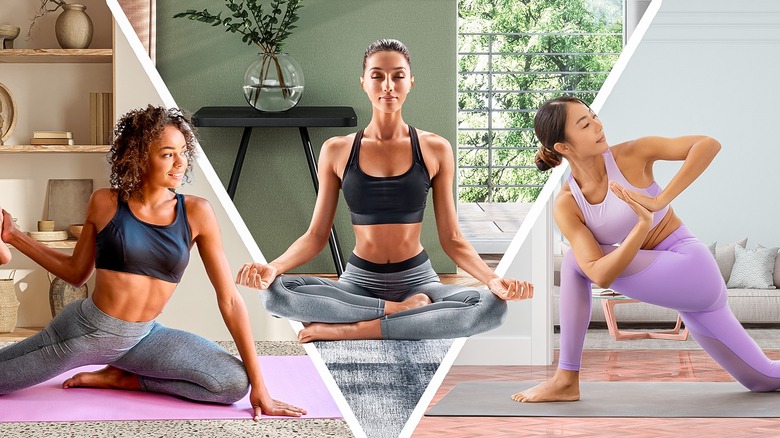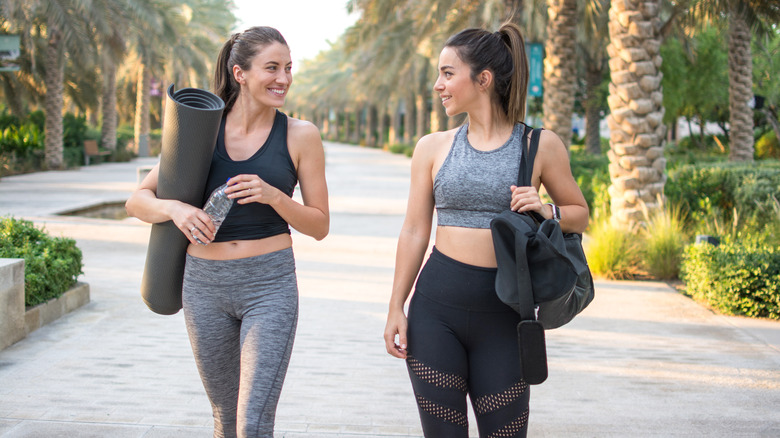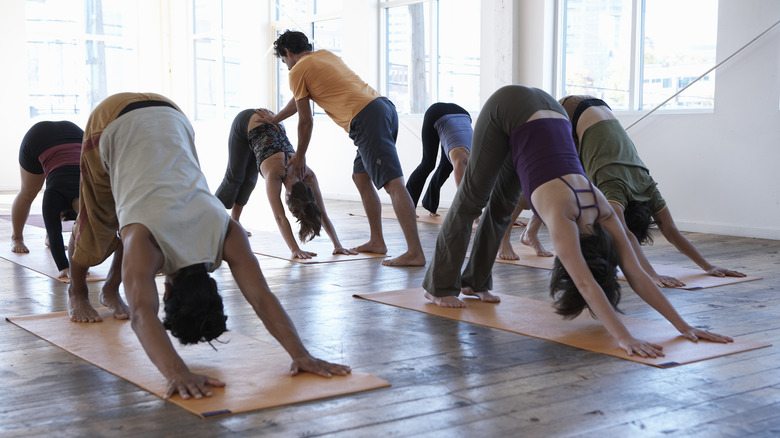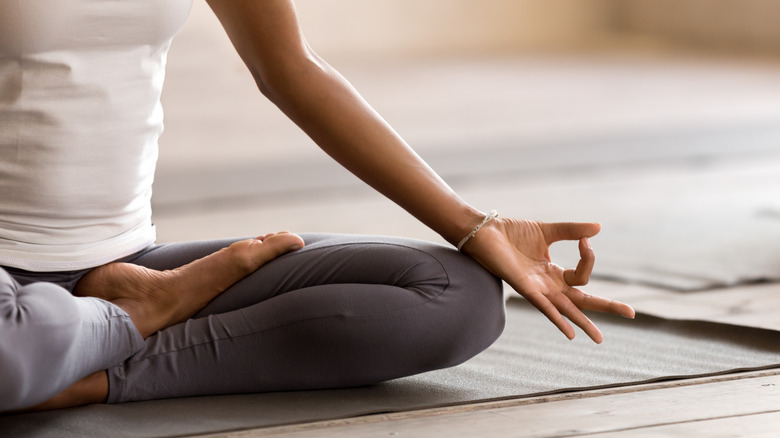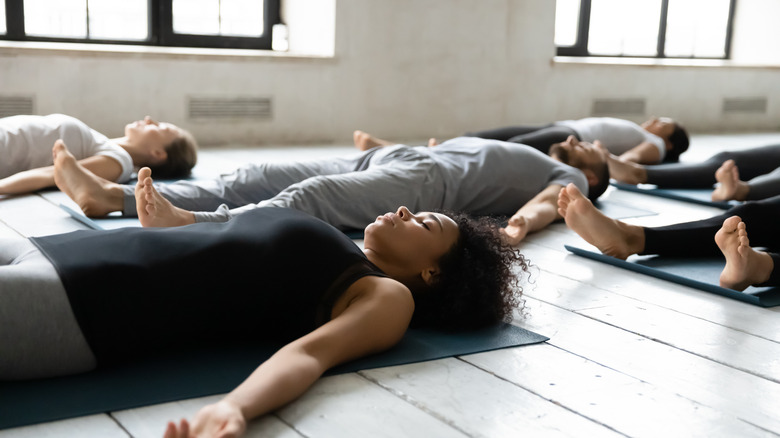What To Expect When Taking A Hatha Yoga Class
If you've ever joined a beginner-level yoga class, chances are high that it was hatha yoga — the practice can also be taught at intermediate and expert levels. Some other yoga methods, like bikram or kundalini yoga, may feel a bit more intimidating to try without prior yoga experience, but the hatha yoga flow is what many people in the Western world most commonly know and recognize as yoga today. Its combination of poses, breathwork, and meditation is known to reduce stress levels and improve quality of sleep (via Insider); on the physical side, the movements and stretches benefit your balance, flexibility, core muscles, and posture.
Whether you opt to take an in-person or virtual hatha yoga class, being prepared for what's to follow is always a wise move. Understanding the flow, length, pace, and difficulty of a session will ease you into the practice and guide you to feeling confident and secure in what's ahead — even if it's a totally new experience for you.
What to bring to class
Before you sit down on your yoga mat — which is, of course, one of the items you'll need unless your class indicates that mats are provided — you'll want to make sure that you're dressed as comfortably as possible. Since you'll be moving quite a bit, tighter athletic wear will likely be your best bet to allow for flexibility while limiting unwanted exposure as you twist into different poses. Yoga pants are known for being top-tier when it comes to comfort, so those are sure to do the trick. If you tend to warm up easily, then a lighter top or layered options for removal are a smart choice. (You can always better curate your yoga wardrobe to your liking over time if you decide to stick with the practice.)
Hydration is also key, so having an easily accessible water bottle will make for a much smoother hatha yoga session. You'll probably want a larger vessel — big enough to continue drinking water after class too. Some people also enjoy having a small towel on hand in case of sweat; even though hatha yoga is a slower and gentler exercise, you may still heat up as your muscles work. To refuel after your session, you may want to bring along a healthy post-yoga snack in your bag.
Expect a focus on the breath
If you're new to breathwork, there may be a bit of a learning curve as you go through the intentional breathing exercises involved in hatha yoga. Most hatha yoga classes will use Ujjayi breathing, which is deep, steady, and matches the length of both inhales and exhales. Ujjayi breathing will feel soothing and balanced at the start of your class — but as the practice becomes a little more involved and you start moving your body, it may take more focus to keep up that breathing.
"To start, you'll typically focus on the breath and warm up the body with gentle movements such as child's pose, spinal rolls, and gentle twists," certified yoga instructor Adrienne Leslie told Insider. "You'll continue to build heat through a flow, moving with the breath for several minutes." As you continue your hatha yoga practice, you may begin to explore more advanced breathwork exercises.
Slower posture holds
Your beginner's hatha yoga class may include words like "gentle" or "restorative" in its course description, and this is essentially what the class entails. The pace of a beginner's hatha yoga class will be smooth and slow. The instructor will lead you through a range of poses, both seated and standing — and you'll be focusing on your breathwork throughout these sequences. You may still go through a few faster progressions — such as sun salutations — in a hatha yoga class in addition to mellower and more restful poses, but these will still be far less intense than a cardio or HIIT-based workout.
You may notice in a hatha yoga class that you hold the postures for longer. While this may feel difficult for some poses, it's typically a way of gently elongating the stretch of the pose and leading yourself into full-body restoration. If you ever find the movements to be too uncomfortable or challenging, not to worry — most instructors encourage participants to take a rest in child's pose until they feel like continuing on.
You may be led through mantras and mudras
Hatha yoga classes may include the use of mudras, or hand and finger positionings that direct a flow of energy and are symbolic of a desired shift. For example, you most likely recognize and associate the "consciousness seal" with yoga and meditation — done by connecting the tips of the pointer finger and thumb (via Yoga Journal). This mudra guides us into greater receptivity, encouraging stillness in the mind and a more uplifted mood.
It's likely you will also be led through mantras or affirmations. Your yoga instructor may set an intention for the class practice — perhaps for you to let go and clear your mind, to hold self-love at the center of your being, or to ground into wellness. It's also possible that they'll choose a mantra, which is a Sanskrit word meaning "to free the mind of limitations" (via Tummee). These mantras may be softly chanted together before the class, and you'll be directed to hold the mantra in your mind throughout the session.
Closing meditation
As your hatha yoga class comes to a close, you'll be led through meditation, sometimes with gentle music, singing bowls, or guided visualizations. This period of rest and deep relaxation is a beautiful reward for your effort and focus throughout the class. Your instructor may speak about the affirmations or mantras you practiced at the beginning of the class and the full circle that you've gone through together during your session time.
The brief meditation is a time to let the practice sink in and to reflect on how you're feeling now that you've gone through the flow. You may even find that you're so deeply relaxed you begin to drift off to sleep. "To let the practice settle in the body, you'll end class in a restorative pose either seated or on your back to find stillness and reflection," certified yoga instructor Adrienne Leslie told Insider. Your only duty for the end-of-class meditation is to relax and soak in the rewards of your practice.
